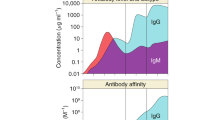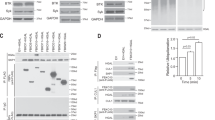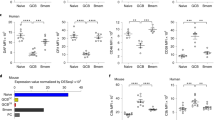Abstract
The pre-B cell receptor (preBCR), composed of μ immunoglobulin (Ig) and surrogate light chains, signals large 'preB-II' cells to proliferate in the apparent absence of ligands or cooperating cells. We deleted the N-terminal, nonimmunoglobulin (nonlg) portion of λ5, or mutated seven arginine residues in it to serine residues. PreBCRs with such mutant λ5 proteins showed increased cell surface representation and a diminished rate of aggregation and internalization. Tyrosine phosphorylation of preBCR complexes containing mutant λ5 proteins was abolished. These results indicate that the nonIg portion of λ5, and the seven arginine residues in it, are needed for signal transduction, and that signaling could be cell autonomous. We propose two models to explain the apparently constitutive, ligand-independent signal-transducing capacity of the preBCR.
This is a preview of subscription content, access via your institution
Access options
Subscribe to this journal
Receive 12 print issues and online access
$209.00 per year
only $17.42 per issue
Buy this article
- Purchase on Springer Link
- Instant access to full article PDF
Prices may be subject to local taxes which are calculated during checkout






Similar content being viewed by others
References
Melchers, F. et al. Repertoire selection by pre-B-cell receptors and B-cell receptors, and genetic control of B-cell development from immature to mature B cells. Immunol. Rev. 175, 33–46 (2000).
Melchers, F. Fit for life in the immune system? Surrogate L chain tests H chains that test L chains. Proc. Natl. Acad. Sci. USA 96, 2571–2573 (1999).
Karasuyama, H., Kudo, A. & Melchers, F. The proteins encoded by the VpreB and λ5 pre-B cell-specific genes can associate with each other and with μ heavy chain. J. Exp. Med. 172, 969–972 (1990).
Tsubata, T. & Reth, M. The products of pre-B cell-specific genes (λ5 and VpreB) and the immunoglobulin μ chain form a complex that is transported onto the cell surface. J. Exp. Med. 172, 973–976 (1990).
Melchers, F. et al. The surrogate light chain in B-cell development. Immunol. Today 14, 60–68 (1993).
Gauthier, L., Lemmers, B., Guelpa-Fonlupt, V., Fougereau, M. & Schiff, C. μ-surrogate light chain physicochemical interactions of the human preB cell receptor: implications for VH repertoire selection and cell signaling at the preB cell stage. J. Immunol. 162, 41–50 (1999).
Guelpa-Fonlupt, V. et al. The human pre-B cell receptor: structural constraints for a tentative model of the pseudo-light (ΨL) chain. Mol. Immunol. 31, 1099–1108 (1994).
Minegishi, Y., Hendershot, L.M. & Conley, M.E. Novel mechanisms control the folding and assembly of λ5/14.1 and VpreB to produce an intact surrogate light chain. Proc. Natl. Acad. Sci. USA 96, 3041–3046 (1999).
Flemming, A., Brummer, T., Reth, M. & Jumaa, H. The adaptor protein SLP-65 acts as a tumor suppressor that limits pre-B cell expansion. Nat. Immunol. 4, 38–43 (2003).
Hayashi, K. et al. The B cell-restricted adaptor BASH is required for normal development and antigen receptor-mediated activation of B cells. Proc. Natl. Acad. Sci. USA 97, 2755–2760 (2000).
Shimizu, T., Mundt, C., Licence, S., Melchers, F. & Martensson, I.L. VpreB1/VpreB2/λ5 triple-deficient mice show impaired B cell development but functional allelic exclusion of the IgH locus. J. Immunol. 168, 6286–6293 (2002).
Hess, J. et al. Induction of pre-B cell proliferation after de novo synthesis of the pre-B cell receptor. Proc. Natl. Acad. Sci. USA 98, 1745–1750 (2001).
Kitamura, D., Roes, J., Kuhn, R. & Rajewsky, K. A B cell-deficient mouse by targeted disruption of the membrane exon of the immunoglobulin μ chain gene. Nature 350, 423–426 (1991).
Kitamura, D. et al. A critical role of λ5 protein in B cell development. Cell 69, 823–831 (1992).
Mundt, C., Licence, S., Shimizu, T., Melchers, F. & Martensson, I.L. Loss of precursor B cell expansion but not allelic exclusion in VpreB1/VpreB2 double-deficient mice. J. Exp. Med. 193, 435–445 (2001).
Reichlin, A. et al. B cell development is arrested at the immature B cell stage in mice carrying a mutation in the cytoplasmic domain of immunoglobulin β. J. Exp. Med. 193, 13–23 (2001).
Rolink, A.G., Winkler, T., Melchers, F. & Andersson, J. Precursor B cell receptor-dependent B cell proliferation and differentiation does not require the bone marrow or fetal liver environment. J. Exp. Med. 191, 23–32 (2000).
Ceredig, R., Rolink, A.G., Melchers, F. & Andersson, J. The B cell receptor, but not the pre-B cell receptor, mediates arrest of B cell differentiation. Eur. J. Immunol. 30, 759–767 (2000).
Shaffer, A.L. & Schlissel, M.S. A truncated heavy chain protein relieves the requirement for surrogate light chains in early B cell development. J. Immunol. 159, 1265–1275 (1997).
Bradl, H. & Jack, H.M. Surrogate light chain-mediated interaction of a soluble pre-B cell receptor with adherent cell lines. J. Immunol. 167, 6403–6411 (2001).
Karasuyama, H. et al. The expression of Vpre-B/λ5 surrogate light chain in early bone marrow precursor B cells of normal and B cell-deficient mutant mice. Cell 77, 133–143 (1994).
Guo, B., Kato, R.M., Garcia-Lloret, M., Wahl, M.I. & Rawlings, D.J. Engagement of the human pre-B cell receptor generates a lipid raft-dependent calcium signaling complex. Immunity 13, 243–253 (2000).
Winkler, T.H., Rolink, A., Melchers, F. & Karasuyama, H. Precursor B cells of mouse bone marrow express two different complexes with the surrogate light chain on the surface. Eur. J. Immunol. 25, 446–450 (1995).
Muljo, S.A. & Schlissel, M.S. The variable, CH1, CH2 and CH3 domains of Ig heavy chain are dispensable for pre-BCR function in transgenic mice. Int. Immunol. 14, 577–584 (2002).
Karasuyama, H., Rolink, A. & Melchers, F. A complex of glycoproteins is associated with VpreB/λ5 surrogate light chain on the surface of μ heavy chain-negative early precursor B cell lines. J. Exp. Med. 178, 469–478 (1993).
Leptin, M. et al. Monoclonal antibodies specific for murine IgM I. Characterization of antigenic determinants on the four constant domains of the μ heavy chain. Eur. J. Immunol. 14, 534–542 (1984).
Lassoued, K. et al. Expression of surrogate light chain receptors is restricted to a late stage in pre-B cell differentiation. Cell 73, 73–86 (1993).
Fuhrmann, U., Bause, E., Legler, G. & Ploegh, H. Novel mannosidase inhibitor blocking conversion of high mannose to complex oligosaccharides. Nature 307, 755–758 (1984).
ten Boekel, E., Melchers, F. & Rolink, A.G. Changes in the V(H) gene repertoire of developing precursor B lymphocytes in mouse bone marrow mediated by the pre-B cell receptor. Immunity 7, 357–368 (1997).
Silverman, G.J. et al. A B cell superantigen-induced persistent “Hole” in the B-1 repertoire. J. Exp. Med. 192, 87–98 (2000).
Winkler, T.H., Melchers, F. & Rolink, A.G. Interleukin-3 and interleukin-7 are alternative growth factors for the same B-cell precursors in the mouse. Blood 85, 2045–2051 (1995).
Wasserman, R. et al. A novel mechanism for B cell repertoire maturation based on response by B cell precursors to pre-B receptor assembly. J. Exp. Med. 187, 259–264 (1998).
Rolink, A., Grawunder, U., Haasner, D., Strasser, A. & Melchers, F. Immature surface Ig+ B cells can continue to rearrange κ and λL chain gene loci. J Exp Med 178, 1263–1270 (1993).
Takemori, T., Miyazoe, I., Shirasawa, T., Taniguchi, M. & Graf, T. A temperature-sensitive mutant of Abelson murine leukemia virus confers inducibility of IgM expression to transformed lymphoid cells. EMBO J. 6, 951–956 (1987).
Ho, S.N., Hunt, H.D., Horton, R.M., Pullen, J.K. & Pease, L.R. Site-directed mutagenesis by overlap extension using the polymerase chain reaction. Gene 77, 51–59 (1989).
Chambers, J.D., Simon, S.I., Berger, E.M., Sklar, L.A. & Arfors, K.E. Endocytosis of β2 integrins by stimulated human neutrophils analyzed by flow cytometry. J. Leukoc. Biol. 53, 462–469 (1993).
Ohnishi, K. & Takemori, T. Molecular components and assembly of μ.surrogate light chain complexes in pre-B cell lines. J. Biol. Chem. 269, 28347–28353 (1994).
Hartley, D. & Corvera, S. Formation of c-Cbl.phosphatidylinositol 3-kinase complexes on lymphocyte membranes by a p56lck-independent mechanism. J. Biol. Chem. 271, 21939–21943 (1996).
Acknowledgements
We thank H. Karasuyama for the SL156 and LM34 antibodies; and T. Takemori and K. Karjalainen for advice and discussions. This work was supported in part by grants to F.M. from the Swiss National Funds (No-3100-066682.01/1) and to K.O. from the Japan Society for the Promotion of Science (KAKENHI 14570290).
Author information
Authors and Affiliations
Corresponding author
Ethics declarations
Competing interests
The authors declare no competing financial interests.
Rights and permissions
About this article
Cite this article
Ohnishi, K., Melchers, F. The nonimmunoglobulin portion of λ5 mediates cell-autonomous pre-B cell receptor signaling. Nat Immunol 4, 849–856 (2003). https://doi.org/10.1038/ni959
Received:
Accepted:
Published:
Issue Date:
DOI: https://doi.org/10.1038/ni959
This article is cited by
-
Tuning charge density of chimeric antigen receptor optimizes tonic signaling and CAR-T cell fitness
Cell Research (2023)
-
Role of Bruton’s tyrosine kinase in B cells and malignancies
Molecular Cancer (2018)
-
Autoimmunity checkpoints as therapeutic targets in B cell malignancies
Nature Reviews Cancer (2018)
-
A generalized quantitative antibody homeostasis model: regulation of B‐cell development by BCR saturation and novel insights into bone marrow function
Clinical & Translational Immunology (2017)
-
Adhesion receptors involved in HSC and early-B cell interactions with bone marrow microenvironment
Cellular and Molecular Life Sciences (2016)



